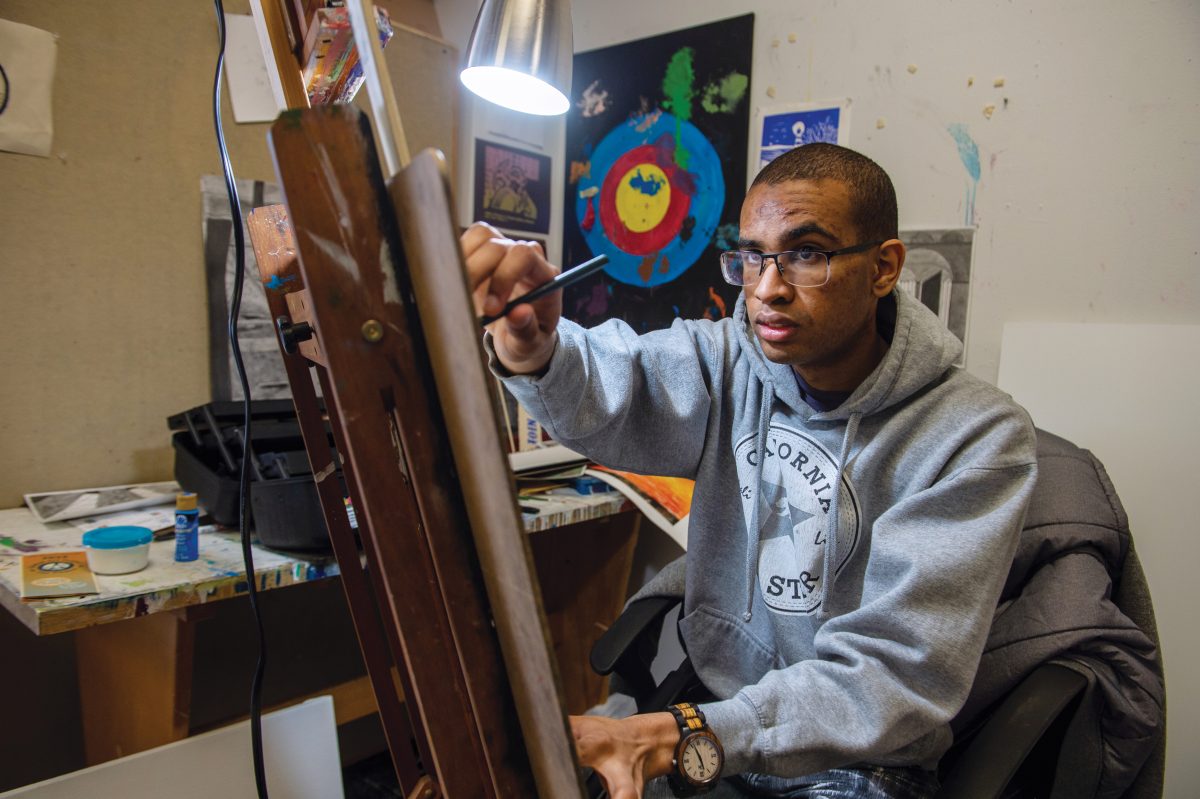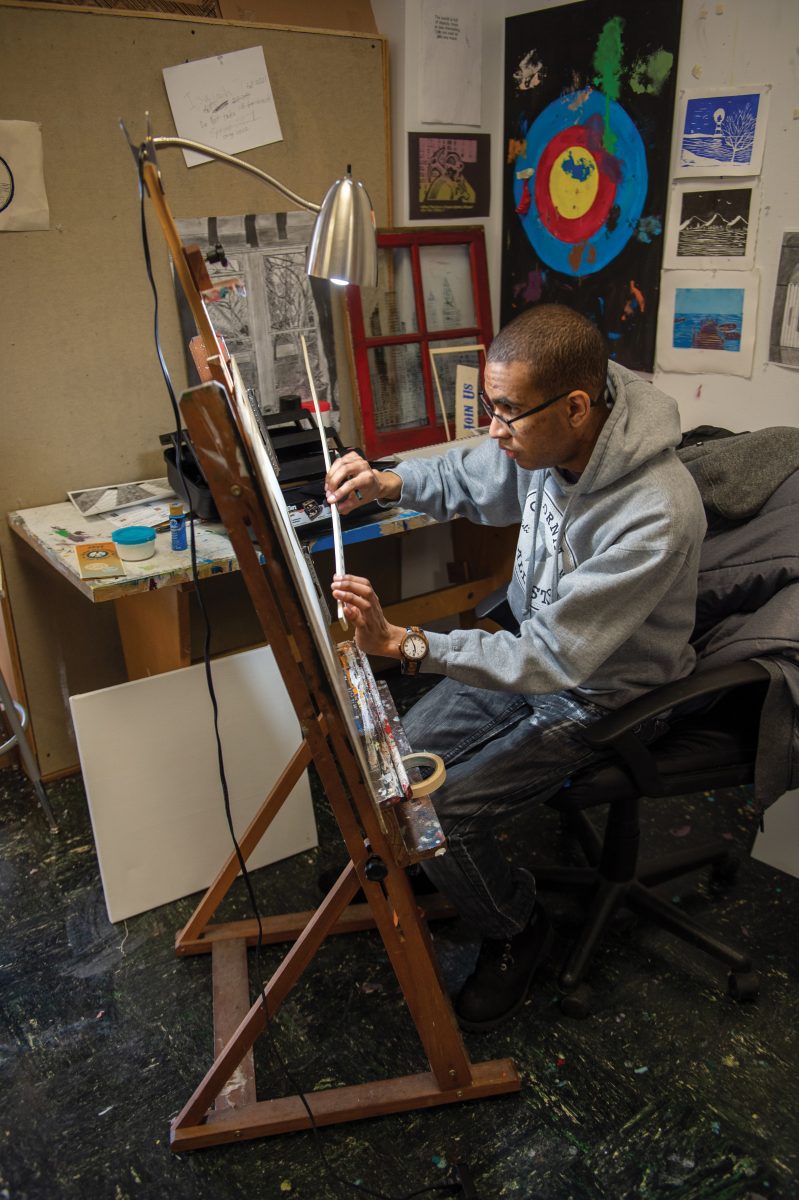
St. Cloud State senior Isaiah Okongo pulls out his phone, scrolling through dozens and dozens of photos of art in his camera roll.
He finally clicks on what he desired: a sketch drawing of the way he sees the world.
“Pictures are better at describing than just seeing, so it gives more context to what it’s like,” Okongo said. “I can’t see out of my right eye other than light; I can see really close-up movement, but it’s really week in that eye. My left eye is the strongest eye, but I can’t see things at a distance very well … anything really close up is my best bet.”
This visual aid is much easier than describing his condition in casual conversation with friends or family. Okongo was born with Optic Nerve Hypoplasia, where his optic nerves are too small to see properly. His optic nerves grew until he was three years old, and his vision has been stable since.
His visual impairment has had no effect on his budding art career, where his attention to detail and passion for architecture have been transformed into works of art that people are already clamoring to buy.
Take a previous summer for example. During Art Crawl St. Cloud, Art Professor Peter Happel Christian saw Okongo set up outside near Falcon National Bank. Happel Christian approached with his family, but he couldn’t even get close to his student: Okongo was engrossed with a crowd of customers discussing and admiring his drawings.
This came as no surprise to his professor.
“It has a lot to do with the nature of his work and who he is; he’s so easy to have a conversation with,” Happel Christian said. “He’s also really genuine in the feedback he gives his peers. He’s good at being complimentary but isn’t shy about being constructive. He’s genuine and honest.
“He’s a presence in the Art building.”
Okongo won first prize in the Miller Center Student Art Show this fall, the first time it had been held since 2019. He received a $100 purchase prize for finishing in first place, with the Miller Center purchasing “Granite Exchange Building”.
His ink drawing of the historic building in downtown St. Cloud is just one piece of a larger series that is his greatest collection to date.
Perspective Drawing
Okongo grew up in Sauk Rapids and has lived in the St. Cloud Area his whole life. The 22-year-old didn’t always strive to be an artist, instead envisioning himself as an architect growing up. That fascination with buildings and attention to detail is abundantly clear in his perspective drawings.
“I capture places in a way I can’t see them,” Okongo said. “A lot of the details in my drawings I can’t see in real life, they’re just too far away. It’s a way to understand the world around me.”
He relies heavily on the technique armatures of a rectangle in his work, something he learned from SCSU Art Professor Justin Quinn in 2019.
“I learned something I didn’t know, and now I can build on that,” Okongo said. “In art you really have to have the idea of what you want to do … you also have to push yourself, it’s a two-way thing.

“That’s with any subject, professors can give you the stepping stones that you need, but it also takes work on the student’s part to really branch off from there … A lot of my recent success has come since I came to St. Cloud State.”
If you draw diagonal lines in a rectangle and divide them in half, it will give you the exact center. If you further split with diagonal lines, it will create a fourth, and other designs can create thirds, fifths, whatever fraction you desire.
“That process really makes it the most accurate, and it means I don’t have to measure it with a ruler, which I can’t really see the measurements on a ruler anyway,” Okongo said. “It’s really instrumental in being accurate … sometimes when I’m dealing with really tiny details on the drawing itself, I have a headset magnifier known as the IrisVision goggles.”
Quinn has been impressed with Okongo since he had him in the first foundational drawing class that Art majors take at SCSU.
“He’s working all the time: he’s so dedicated to his craft and to making and exhibiting,” Quinn said. “He’s taking the steps to being a professional artist.
“He blew me away with his maturity and his outlook and plans … it wasn’t only the work, but the way he talked about the work and what he wanted to do as a professional,” he added. “He’s the real deal.”
Quinn described Okongo’s building series as very mathematical, where the illusion of depth is created by lines that recede back into space. Layering on perspective creates elegant, three-dimensional blueprints of space.
Okongo estimates he’s done about 30 of these perspective drawings of buildings since 2020. He began close to home with St. Cloud buildings, now expanding throughout the state to visit places like Minneapolis or Stillwater. Sometimes he will even stumble across his next drawing focus by accident.
His simplest piece took only about 2-3 weeks, while his largest took about three months. He often works 2-3 hours a day on drawings, which he uses as an effective way to unwind late in the day.
Okongo uses pen for the drawings, with pencil being too light for him to accurately see. He shades in pen too, which isn’t a skill many take advantage of.
SCSU professor Peter Happel Christian said Okongo also has shown an openness to developing his photographic skills, finding ways to weave it into his main artistic focus.
“Working with a camera fed into his interest in architecture and drawing buildings,” Happel Christian said. “He finds way to make the materials connect to making as he understands it.”
Okongo will use photographs of the building to see the finer details of the structure, always striving to complete more complex drawings in a further goal of hyper-realism. He’s not burning out on the project any time soon, and he even has larger goals for the future.
Advocacy
Dreams of being an architect have been replaced by a desire to be an art director or art professor in the future. The process of selecting and judging art or helping others create is a passion, and he wants to encourage students to think about accessible art for visually impaired people and those with other sensory needs.
“I have many visually impaired friends that can’t experience what I do,” Okongo said. “I really want to start making the art world more inclusive.”
This past August he helped create an exhibition at Art in Motion in Holdingford, Minn., with his own piece comprising of wood blocks with multiple carvings he’d made in his multimedia class.
The carvings were based on hand drawings and put into a box. Anyone that came could reach into the box and feel the art, experiencing the sensation of feeling without seeing.
“I wanted to really explore this idea of doing art that’s not the traditional picture hanging on a gallery wall,” Okongo said. “For people who had sight, they could also add another element where they could draw what they felt without looking at it to see what they’d interpret out of it. There’s no right or no wrong (answer), I just wanted to see what people would interpret when they felt things.
“I have all the drawings people made from that in my studio now. It’s really interesting to see what people came up with, and it was a really major hit at that exhibition.”
Professor Justin Quinn admires Okongo’s community-driven plans and connections he’s already made as he begins to sell his work and appear in shows.
“He knows who he is and what he’s making: he’s taking the first step into being a professional beyond school.”
Okongo continues to take advantage of his professor’s advice and facilities on campus as he wraps up his final semester at SCSU. His college experience has allowed him to see his art flourish and resonate in the community he’s known his whole life. And it’s allowed him to further experience his favorite part about art: how people can connect to his work.
“You really start to look at things from different angles than you would beforehand,” Okongo said about his time at SCSU. “Here they really try to make you think deeper about all kinds of things, whether it’s Ethnic Studies, Anthropology, History, it’s all connected. If you think deeper of it, you can express yourself in different ways.
“A lot of people do that in their written essays: I do so through my art.”
